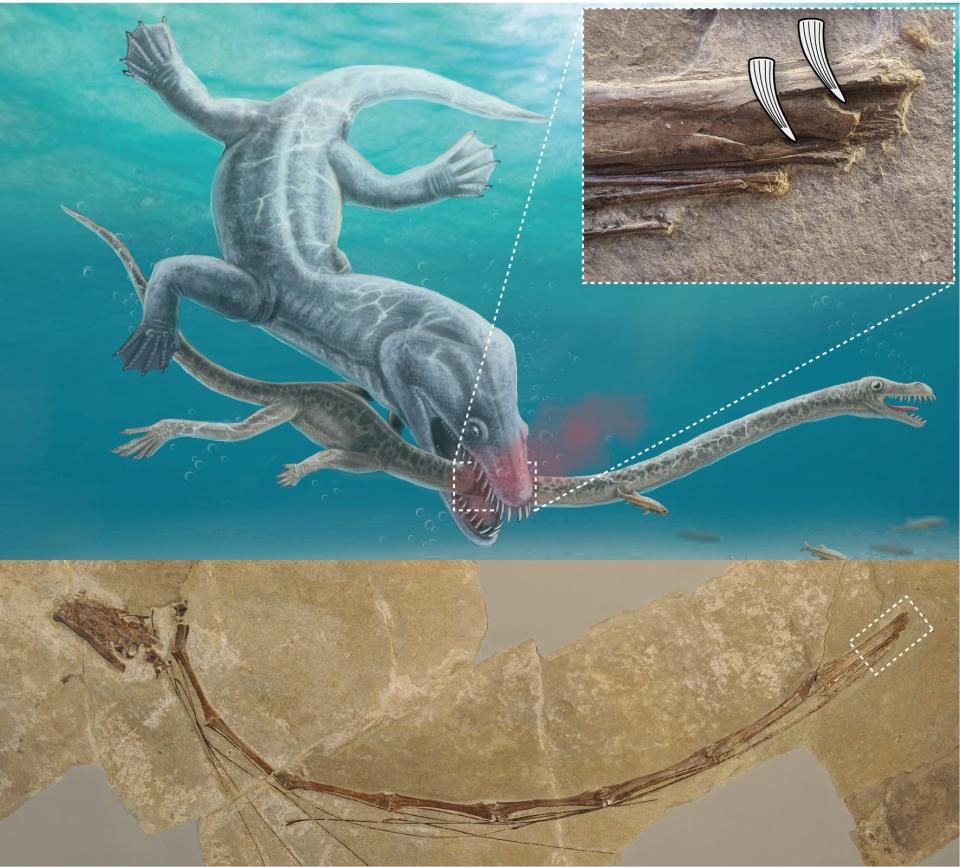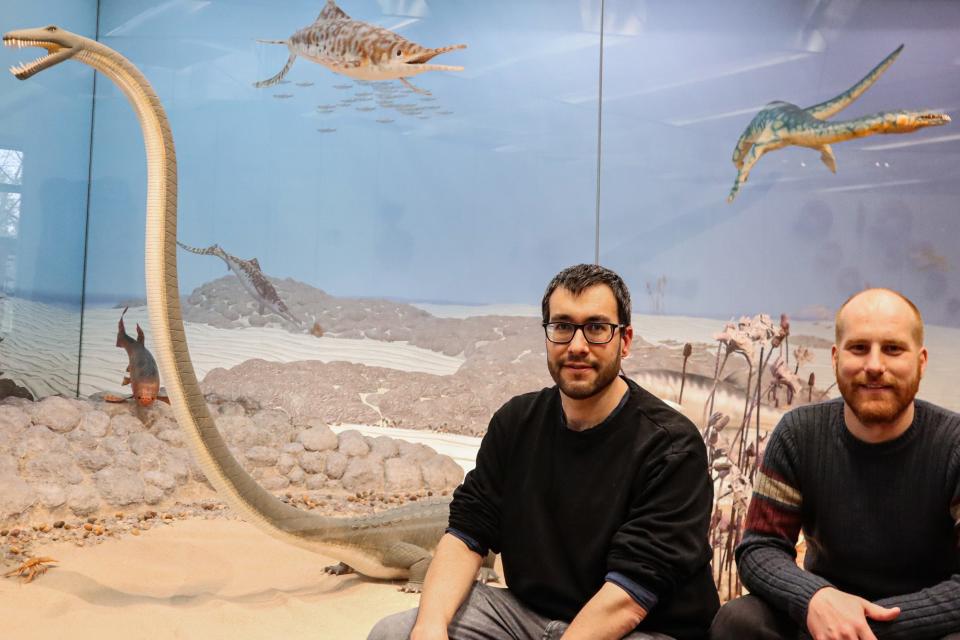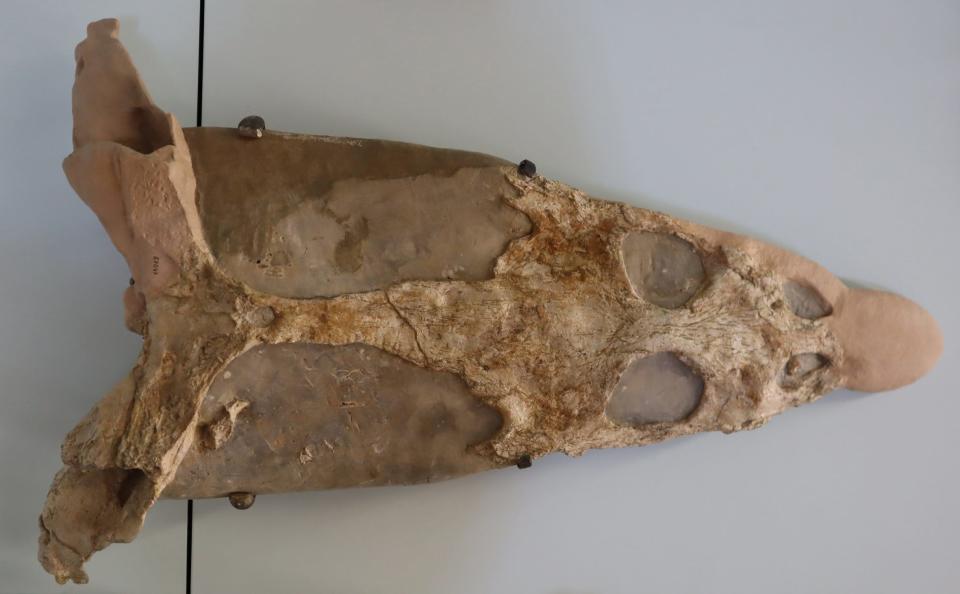Sea monsters used to snack on this swimming dinosaur with a long neck, scientists find
Littlefoot. Loch Ness monster. Dino from The Flintstones.
We're so used to seeing long-necked dinosaurs and other scaly creatures in popular culture. The cartoons and cultural characters are loosely based on real-life dinosaurs from hundreds of million of years ago that had much longer necks than any reptile alive today: Crocodiles, lizards, Komodo dragons (oh my!).
It turns out that for pre-historic marine reptiles — think Loch Ness monster — their long necks made them targets because the lengthy, fleshy body part was particularly vulnerable to predators.
In what we think of as the land before time, a dino neck was a tasty morsel that was an easy snack for hungry, meat-eating sea monsters, according to fresh fossil evidence scientists are hailing as a long-time-coming discovery.

How marine pre-historic reptiles lost their heads
Scientists have for decades theorized that the reptile's fleshy neck was a soft target, according to a study published Monday in the journal Current Biology. New fossil evidence finally confirms that theory, the authors say.
Scientists studied a pre-historic reptile named Tanystropheus that lived long before T-Rex and is technically not a dinosaur.
"During this time period there were a bunch of different reptiles around, many of them very big and weird and scary and interesting," said Stephan Spiekman of the State Museum of Natural History in Stuttgart, Germany.
Fossils from two different species of Tanystropheus show bites marks on their necks, which were broken in half at the point of the bite, the study says.

"The findings offer gruesome and exceedingly rare evidence for predator-prey interactions in the fossil record going back over 240 million years ago," a press release from the journal's publisher says.
Spiekman said he was able to identify and interpret the neck injury present in the fossil because he coincidentally shared an office at work with "an expert specifically on studying bite marks" named Eudald Mujal Grané, the co-lead author of the study.
Scientists stick their necks out to win race, discover evidence first
Evidence of this type of long-necked reptile existed for an "extremely long time" in the fossil record, Spiekman said — longer than the amount of time separating today's humans from T-Rex: 175 million years vs. 66 million years.
Since the first moment scientists started finding fossils of this animal, people hypothesized that their necks could have easily been attacked by predators, the authors say.
"This is the first time in over 200 years we've proved that these necks were indeed vulnerable to being attacked, despite their huge evolutionary success for such a long time," Spiekman said.

Tanystropheus likely spent most of its time in the water, until getting chomped
The species Spiekman studied, Tanystropheus, had unique necks composed of 13 "extremely elongated" vertebrae.
Small versions of Tanystropheus would eat soft-shelled animals like shrimp, and larger Tanystropheus fed on fish and squid, Spiekman found. The larger version was as long as 19 feet.
"Tanystropheus itself was quite successful in evolutionary terms, living for at least 10 million years and occurring in what is now Europe, the Middle East, China, North America, and possibly South America," Spiekman said.
Long necks were also a good thing, scientists say
Very long necks — even longer than on-land dinosaurs like sauropods — were a "highly successful evolutionary strategy" found among many marine dinosaurs, the press release says.
It's likely the long neck helped the creatures surprise their prey and grab a bite to eat by just peaking their head around a corner, while keeping their much larger bodies hidden, Spiekman said.
"If you have such a small head so far away from the body, you can approach your prey very easily without being spotted," he said. "I imagine an animal catching its prey before it even knows it's there."
The reptiles did not use their long necks to stick their heads above the water while swimming, he said. Scientists disproved that in the past, finding that it would have been impossible for the creatures to suck air all the way down their neck amid intense water pressure.
The neck-biting finding shows "evolution is a game of trade-offs," Spiekman said. "The advantage of having a long neck clearly outweighed the risk of being targeted by a predator for a very long time," he said.
This article originally appeared on USA TODAY: Long neck dinosaur was more vulnerable to predators, scientists find

